I’ve made more high altitude lemon cakes over the years than I can remember. When my husband and I were married, I baked and decorated five cakes for our dessert table, as well as an assortment of mini tartlets and shortbread cookies. The lemon cake was easily the favorite with everyone! Even before the first delicious bite, the pale sunshiny color makes me happy. You can fill the layers with lemon curd, or just buttercream, decorate it simply with swirls of frosting, or beautiful, translucent dried lemon slices.
Looking for more lemon recipes? You’ll love honey lemon cupcakes, lavender lemon popsicles, soft and chewy lemonies, and classic lemon tart.
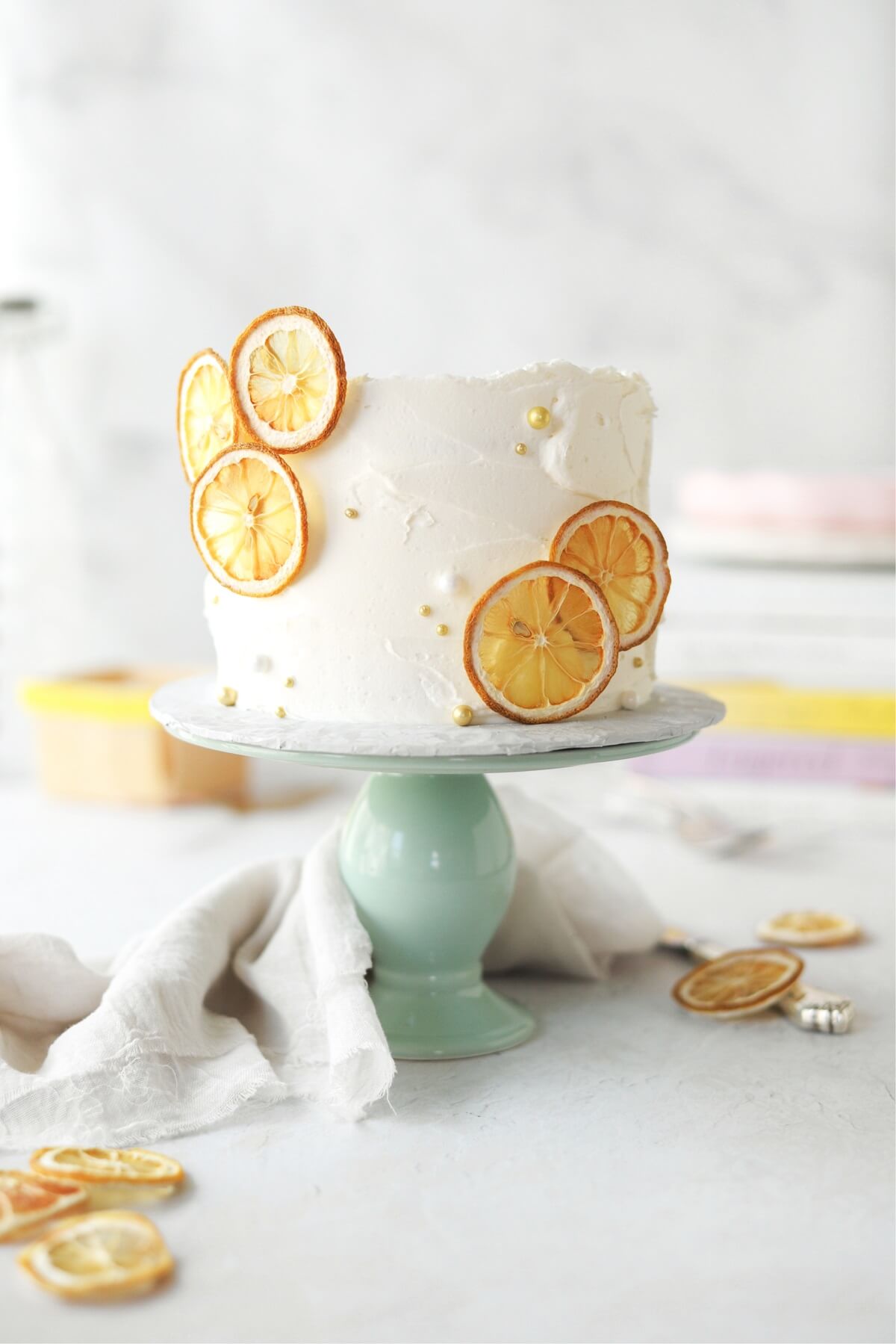
This site contains affiliate links. As an Amazon associate, I earn from qualifying purchases. This means that I may make a small commission if you purchase a product using those links. This in no way affects my opinion of those products and services. All opinions expressed on this site are my own.
Why We Love This Cake
- The cake batter is so easy to make, by simply whisking together wet and dry ingredients.
- It’s light and fluffy, with a soft, delicate crumb, thanks to using cake flour and lemon buttermilk (milk curdled with lemon juice).
- This cake is so moist and soft, beautifully lemony, with a perfect balance of sweet and tart flavors.
- It’s delicious with a variety of fillings, like lemon curd, jam or buttercream.
- It’s high altitude tested. I develop all the recipes on my site for Denver’s altitude of 5,280 feet. If you’re at a lower or higher elevation, please see my FAQs for guidance on adjusting recipes for your altitude.
Ingredients
Granulated Sugar. I used a little more sugar in this cake than I usually use in my high altitude cake recipes. With all the tart lemon juice, it needs a bit of extra sweetness.
Lemon Zest. To really infuse lemon flavor into my cake, I grate lemons over the sugar, and then use my fingers to rub the zest into the sugar. The oils in the lemon zest coat the sugar in fresh lemon flavor, and makes this cake even more wonderful.
Cake Flour. Cake flour makes a very light and fluffy cake, and I highly recommend using it in this recipe, rather than all-purpose flour. I usually use Swan’s Down Cake Flour, and it works wonderfully.
Baking Soda & Baking Powder. Both of these leaveners work together to activate the acidic ingredients and provide a beautiful rise to the cake for a very fluffy crumb.
Coarse Kosher Salt. Everything sweet needs a pinch of salt for flavor and balance.
Lemon Juice. In addition to the lemon zest, the tart lemon juice gives the cake its lemon flavor, as well as acid to help it rise. I used fresh lemons, although you can use bottled lemon juice, too. Lemons vary in size, as well as how much juice they yield. You may need 4 small lemons to get 1/2 cup of juice. Remember, zest the lemons first, before you juice them.
Whole Milk. While I love baking cakes with buttermilk, for this recipe I used whole milk so that I could curdle it with the lemon juice. Doing so essentially creates a “lemon buttermilk”, that makes the most incredible cake.
Sour Cream. A spoonful of sour cream is always a good idea in cakes. It adds moisture, flavor and acidity, and contributes to the tenderness of the cake.
Eggs + Egg Whites. I use 3 whole eggs, plus 2 extra whites in this recipe (for a total of 3 yolks and 5 whites). The eggs provide the structure, stability and moisture, and the extra whites make the cake extra light.
Vegetable Oil. Most cake recipes will contain either butter or oil. Butter-based cakes tend to be more dense and rich, while an oil-based cake will be very moist and light.
Vanilla Extract. Even though this is a lemon cake, I like to add a dash of vanilla to add another flavor note.
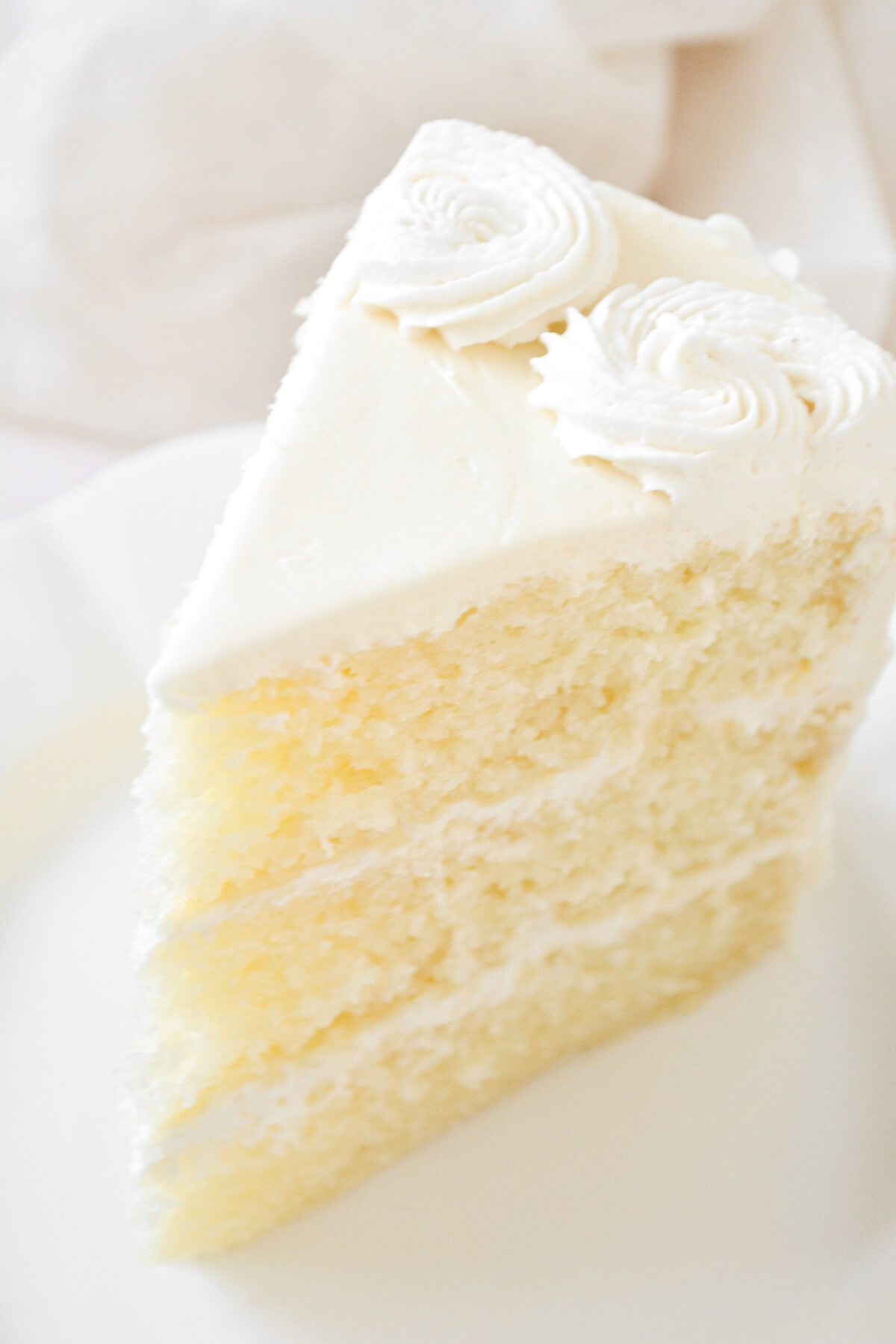
Instructions
Cake
- Preheat the oven to 350 F. Line three 8-inch cake pans with parchment paper in the bottoms of the pans, and spray the paper with non-stick spray. The baked cakes are sticky, and you should not skip this step of lining your pans with parchment paper.
- In a measuring cup, stir together the lemon juice and milk; set aside for about 15 minutes to let the milk curdle.
- Measure the sugar into a large bowl, and zest the lemons over the sugar. Use your fingers to rub the lemon zest into the sugar to really infuse the lemon flavor.
- Set a fine mesh strainer over the sugar, and sift in the flour, baking soda, baking powder and salt, then whisk together the dry ingredients with the lemon sugar.
- In a separate bowl, whisk together the lemon juice/milk mixture, eggs, egg whites, sour cream, oil and vanilla until smooth. Add the wet ingredients to the dry and whisk by hand until smooth, about 30 seconds.
- Divide the batter between the pans. Bake for 25-27 minutes, until a cake tester in the center of the cakes comes out clean and the tops spring back when lightly touched. Set the pans on a wire rack, cover with a clean kitchen towel, and cool completely.
If you haven’t read my comprehensive post on Perfect American Buttercream, please do! There’s a wealth of information there, and if you struggle with your buttercream consistency, flavor and texture, I promise you that I can help you. While there is plenty of fresh lemon juice and zest in the cake, for the buttercream I decided to only use lemon extract and fresh zest. Adding lemon juice to buttercream runs the risk of curdling the butter. I have had this happen sometimes, and other times not. Based on experience, though, it’s best not to add the acidic juice and risk ruining a whole bowl of buttercream.
Buttercream
- In the bowl of your stand mixer fitted with the whisk attachment, beat the butter for one minute until smooth. Scrape the bowl down. With the mixer on low, add the powdered sugar, meringue powder and salt, mixing to combine. Add the lemon extract and vanilla.
- Beat on medium high for about 5 minutes, scraping the bowl down occasionally, until very light and fluffy. Add the milk as needed for desired consistency.
- Fill and frost the cooled cakes with the buttercream.
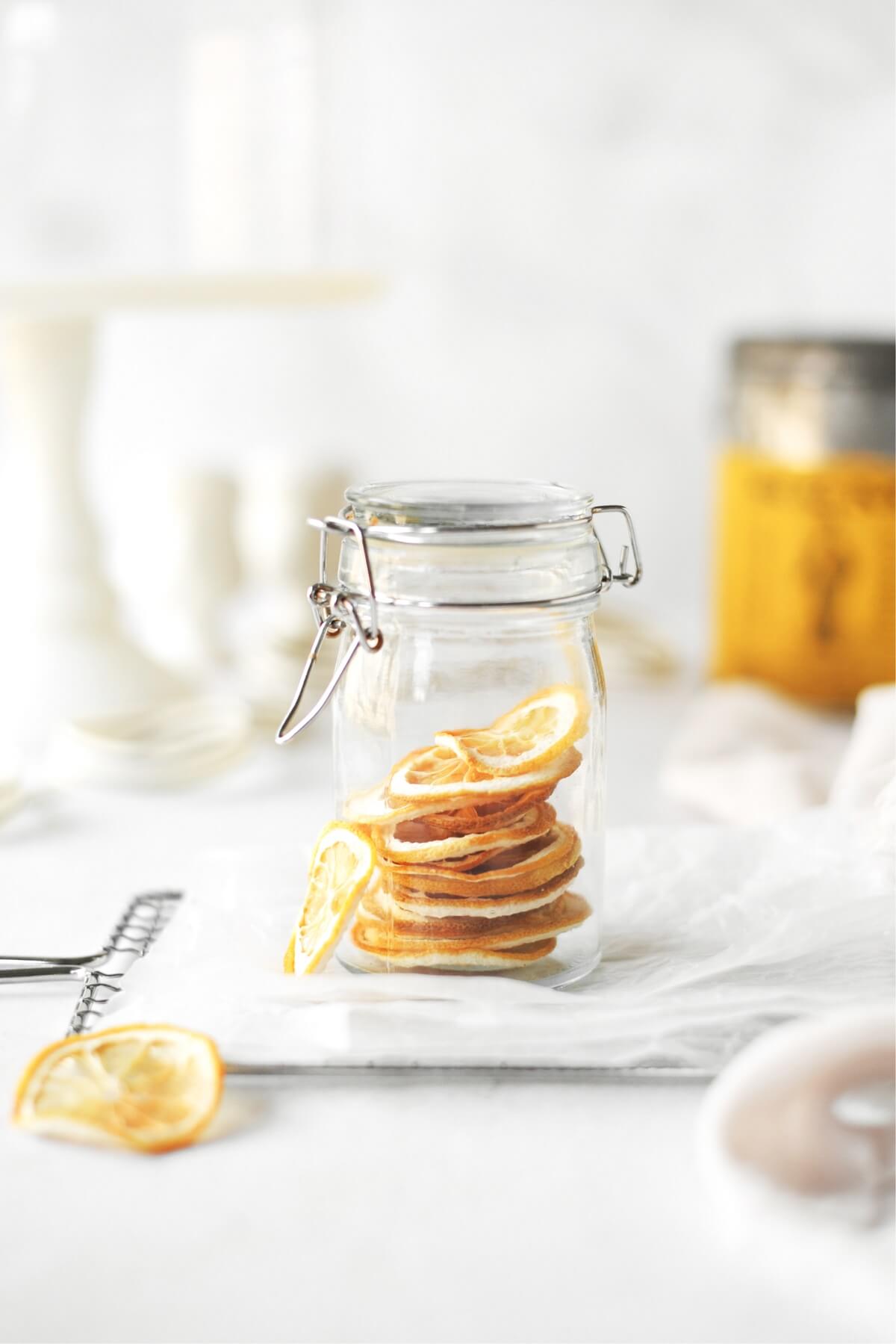


How to Make the Dried Lemon Garnish
Making dried lemons to garnish a cake is incredibly easy, and while they do have to dry in the oven for a few hours, there’s very little active prep time. They retain a beautiful color when dried on low heat, and can be made ahead of time and stored for later, as well. You can follow this exact process for dried lemons, oranges or grapefruit. Obviously, these are not the same as candied lemon slices, and are intended only as garnish, and not to be eaten, since they will taste bitter and not sweet.
- Preheat the oven to 175 F, and line a baking sheet with parchment paper.
- Thinly slice the lemons; I find that about 1/8 of an inch is the right thickness.
- Lay the lemon slices in a single layer on the baking sheet.
- Bake on the center oven rack for 2-3 hours, turning every 30 minutes and rotating the pan if you have hot spots in your oven, until mostly dry and still vivid in color; don’t let them get overly brown.
- Turn off the oven, and let them finish drying in the oven for several more hours, or overnight.
- Place on the cake, using a bit of buttercream as “glue”.
- Any leftover lemons can be stored in an airtight container for as long as they still retain their color.
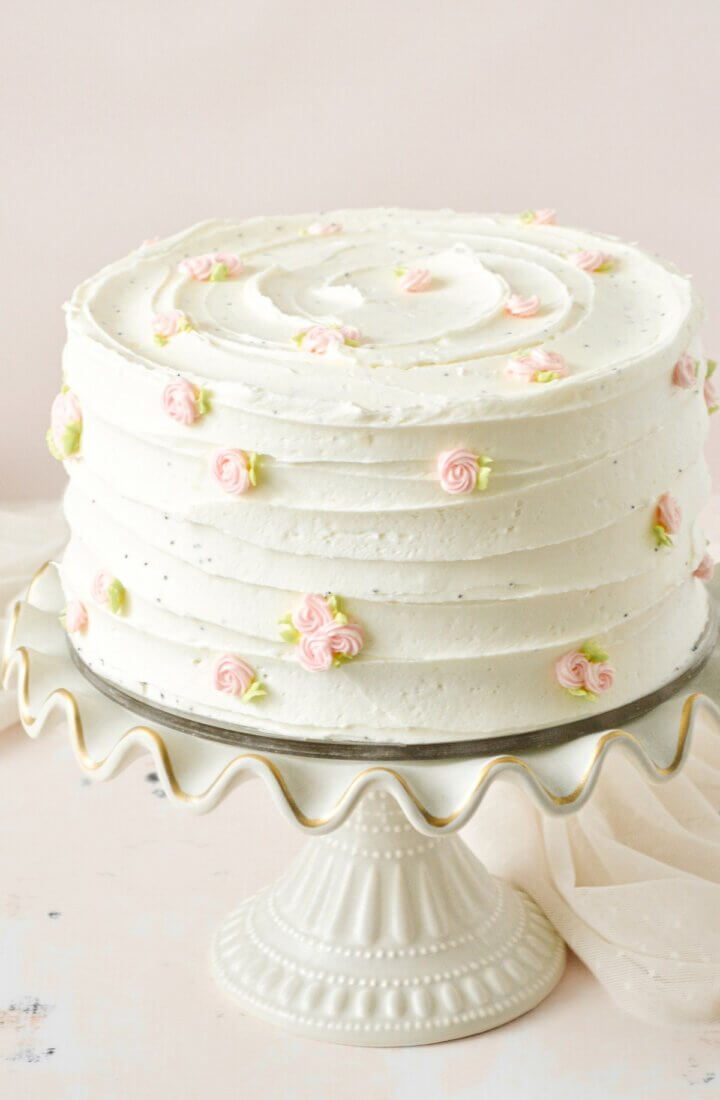
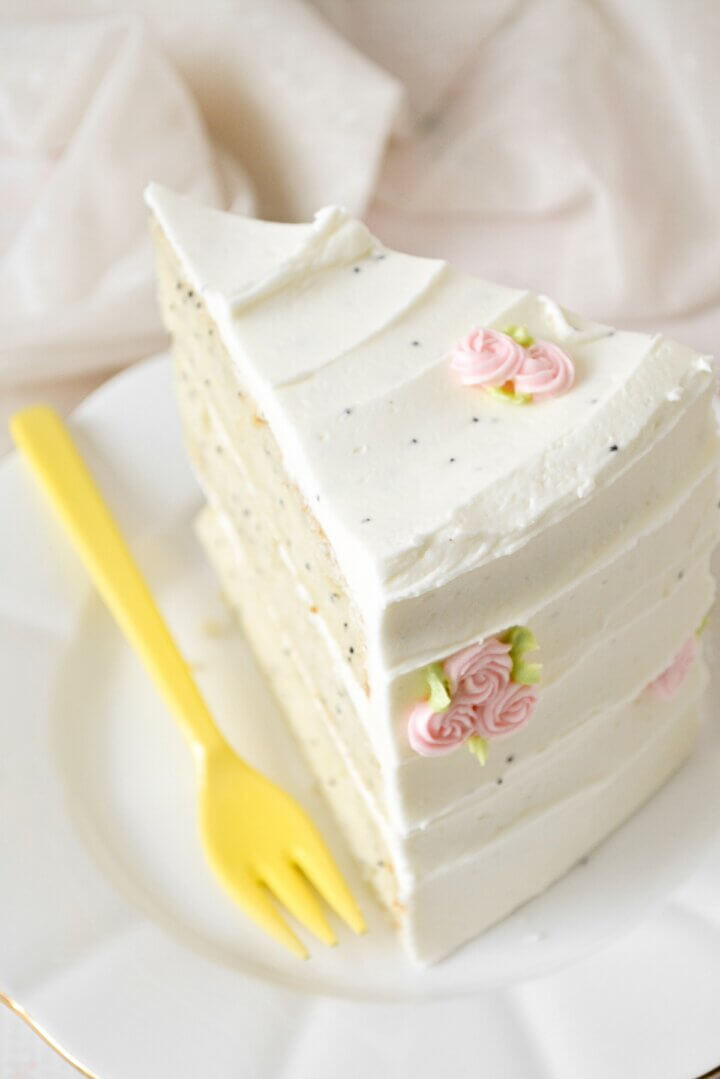
Be sure to read all of my BAKING FAQs where I discuss ingredients, substitutions and common questions with cake making, so that you can be successful in your own baking! I also suggest reading these comprehensive posts on making Perfect American Buttercream, How to Stack, Fill, Crumb Coat and Frost Layer Cakes and How to Use Piping Bags.
Frequently Asked Questions
Do I need to use cake flour?
I’ve only made this recipe using cake flour, and it produces a very light, fluffy cake. All-purpose flour will not give you quite the same result, but should still be fine. Be sure to sift the flour to get out any lumps.
Do I need to let the cold ingredients come to room temperature?
When making cakes, it’s always a good idea to set out your dairy products (eggs, milk, sour cream) an hour or two before you mix your batter, to let them come to room temperature. This just helps the batter mix up better and bake more evenly.
Can I use bottled lemon juice instead of fresh?
You sure can, but since you need fresh lemon zest anyway, you should use the zest and juice from your lemons.
How many lemons do I need?
Honestly, this varies so much, depending on their size, and how much juice they contain. You might need 4-5 small lemons to get 1/2 cup of juice for the cake batter.
Why don’t you add lemon juice to the buttercream?
Although there is plenty of fresh lemon juice and zest in the cake, for the buttercream I decided to only use lemon extract. Adding lemon juice to buttercream runs the risk of curdling the butter. I have had this happen sometimes, and other times not. But based on experience, I think it’s best not to add the acidic juice and risk ruining a whole bowl of buttercream.
How do I keep the cakes from sticking to the pans?
These cakes are extremely light and fluffy, and will stick to your cake pans if you don’t line them with parchment paper. Line the pans with a circle of parchment paper, and spray with non-stick spray to ensure easy release.
Can I make this recipe into a lemon poppy seed cake?
Of course! Just add 2 tablespoons poppy seeds to the dry ingredients before mixing your cake batter.
What flavors of fillings would you recommend for this cake?
If you want to fill your cakes with something other than the lemon buttercream, lemon curd would be delicious, as would raspberry jam.
How long does this cake stay fresh?
It will stay moist and soft for 3-5 days, if stored in an airtight container or cake carrier.
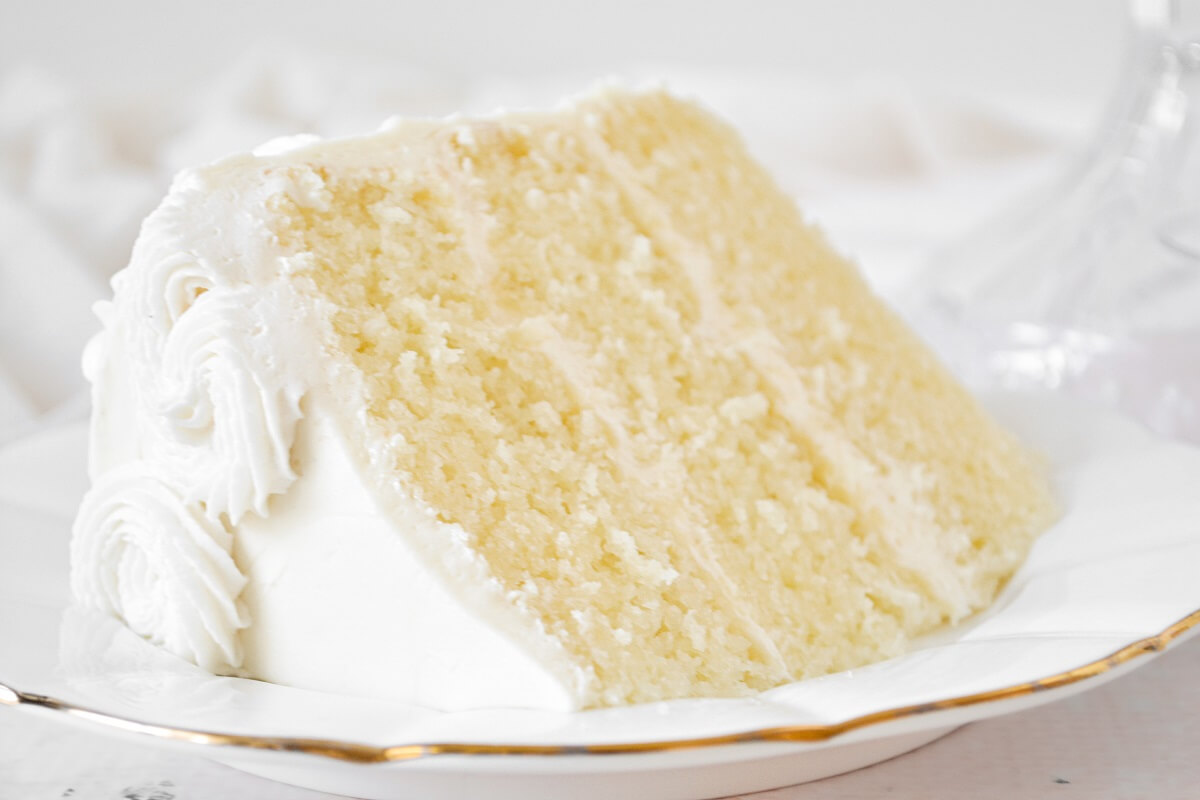
You Might Also Like
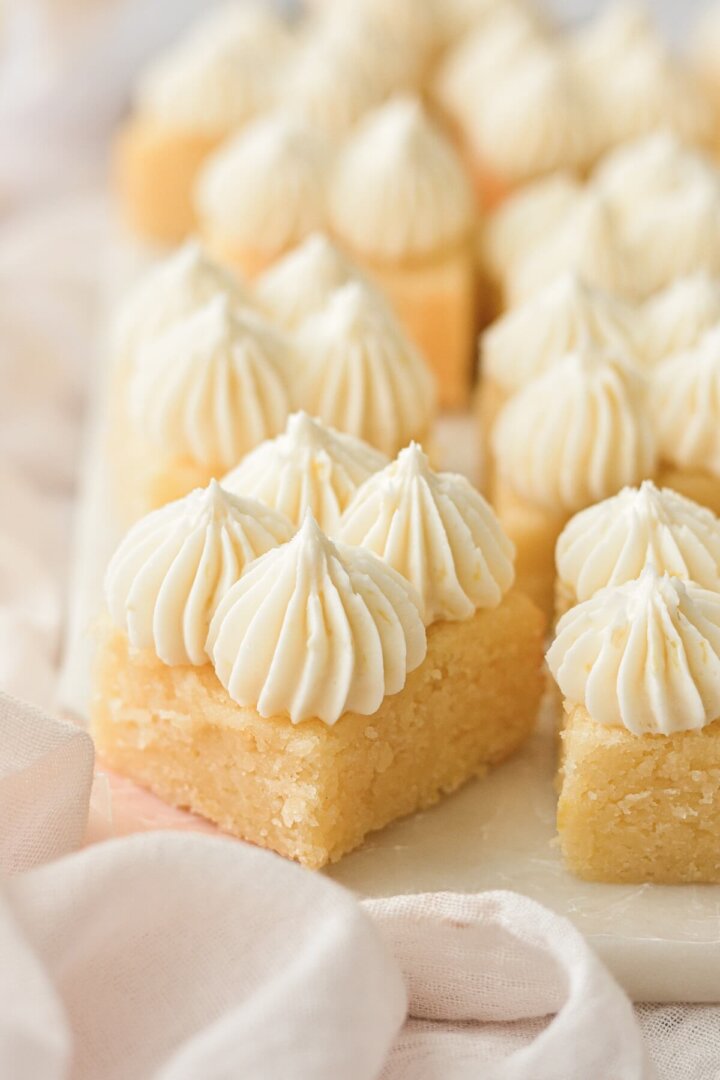
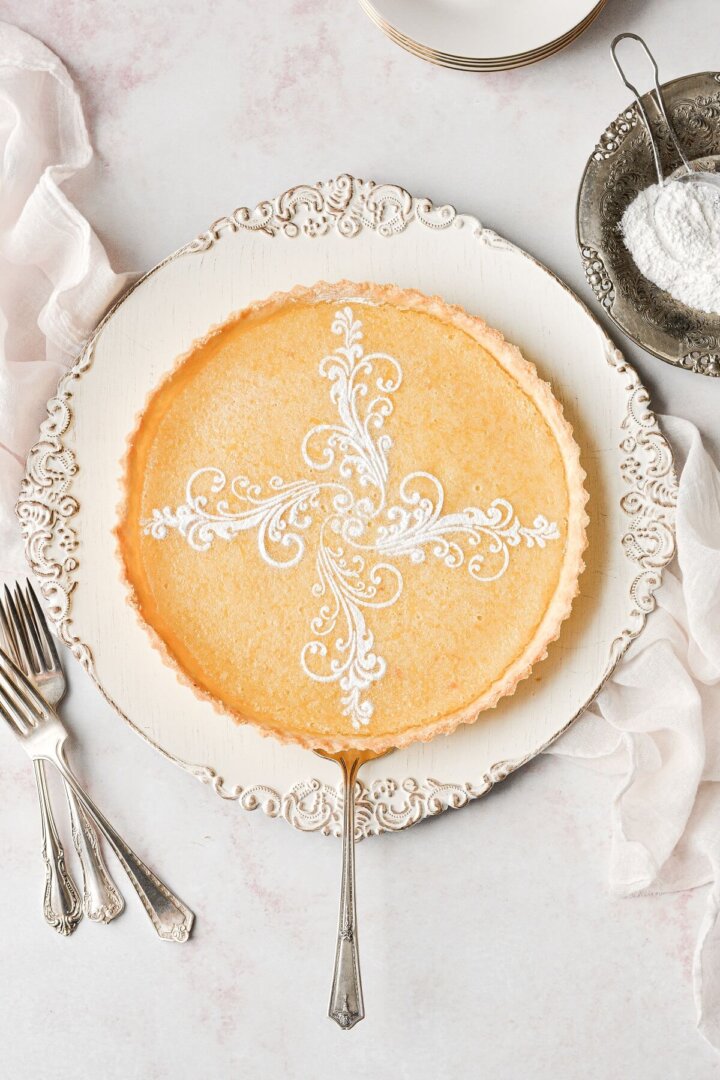

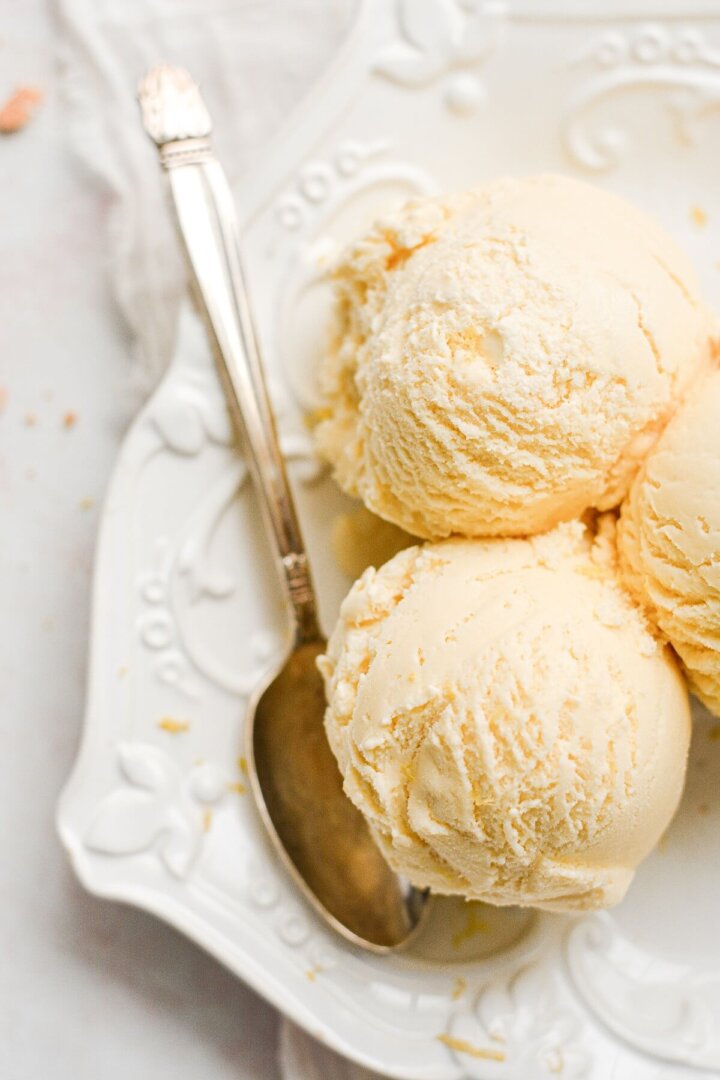
Please check out my Amazon Shop for a curated collection of some of my favorite cake pans from trusted brands, baking tools, ingredients, pretty things and fashion finds. I recommend products that I buy and use every day!
Did you love today’s recipe? Please rate the recipe and let me know in the comments what you thought! Also, be sure to follow Curly Girl Kitchen on Instagram, and tag me when you try one of my recipes so I can see all your delicious creations!
High Altitude Lemon Cake
All recipes on Curly Girl Kitchen are developed for high altitude at 5,280 feet. See FAQs for adjusting to higher or lower elevations.
Equipment
- Stand Mixer
Ingredients
Cake
- ½ cup (133ml) lemon juice, fresh or bottled
- 1 cup (269ml) whole milk
- 2 cups (432g) granulated sugar
- zest of 2 small lemons
- 2 ¾ cups (330g) cake flour, spooned and leveled
- ½ tsp (2.5g) baking soda
- 2 tsp (8g) baking powder
- 1 tsp coarse Kosher salt (if using table salt, use half the amount)
- 3 (165g) large eggs
- 2 (70g) large egg whites only (save the yolks for another use)
- ½ cup (120g) sour cream
- 1 cup (224g) vegetable oil
- 1 tsp (4g) vanilla extract
Buttercream
- 2 cups (452g) unsalted butter, softened to room temperature
- 4 cups (560g) powdered sugar
- 1 tbsp (9g) meringue powder (optional)
- ⅛ tsp coarse Kosher salt (if using table salt, use half the amount)
- 2 tsp (8g) lemon extract
- 1 tsp (4g) vanilla extract
- zest of 1 small lemon
- 2-4 tbsp (33-66ml) milk or cream, if needed
Instructions
Cake
- Preheat the oven to 350 F. Line three 8-inch cake pans with parchment paper in the bottoms of the pans, and spray the paper with non-stick spray. The baked cakes are sticky, and you should not skip this step of lining your pans with parchment paper.
- In a measuring cup, stir together the lemon juice and milk; set aside for about 15 minutes to let the milk curdle.
- Measure the sugar into a large bowl, and zest the lemons over the sugar. Use your fingers to rub the lemon zest into the sugar to really infuse the lemon flavor.
- Set a fine mesh strainer over the sugar, and sift in the flour, baking soda, baking powder and salt, then whisk together the dry ingredients with the lemon sugar.
- In a separate bowl, whisk together the lemon juice/milk mixture, eggs, egg whites, sour cream, oil and vanilla until smooth. Add the wet ingredients to the dry and whisk by hand until smooth, about 30 seconds.
- Divide the batter between the pans. Bake for 25-27 minutes, until a cake tester in the center of the cakes comes out clean and the tops spring back when lightly touched. Set the pans on a wire rack, cover with a clean kitchen towel, and cool completely.
Buttercream
- In the bowl of your stand mixer fitted with the whisk attachment, beat the butter for one minute until smooth. Scrape the bowl down. With the mixer on low, add the powdered sugar, meringue powder and salt, mixing to combine. Add the lemon extract, vanilla extract and lemon zest.
- Beat on medium high for about 5 minutes, scraping the bowl down occasionally, until very light and fluffy. Add the milk as needed for desired consistency.
- Remove the cooled cakes from the pans. Fill and frost the cooled cakes with the buttercream.
Notes
- I’ve only made this recipe using cake flour, and it produces a very light, fluffy cake. All-purpose flour will not give you quite the same result, but should still be fine. Be sure to sift the flour to get out any lumps.
- It’s a good idea to set out your dairy products (eggs, milk, sour cream) an hour or two before you mix your batter, to let them come to room temperature. Large eggs can vary in size, but they should average about 1/4 cup each in volume; three large eggs plus two whites should fill one cup. If your eggs are on the small side, add another to get a full cup.
- Lemons also can vary in size, as well as how much juice they contain. You might need 4 small lemons to get 1/2 cup of juice for the cake batter.
- Although there is plenty of fresh lemon juice and zest in the cake, for the buttercream I decided to only use lemon extract. Adding lemon juice to buttercream runs the risk of curdling the butter; I have had this happen sometimes, and other times not, but based on experience, I think it’s best not to add the acidic juice and risk ruining a whole bowl of buttercream.
- These cakes are extremely light and fluffy, and will stick to your cake pans if you don’t line them with parchment paper. Take this extra step to ensure easy release.
- For a Lemon Poppyseed Cake, add two tablespoons poppy seeds to the dry ingredients.
- To add even more tart lemony goodness, you can spread a bit of lemon curd between each cake layer.
- Be sure to review my Baking FAQs for my other tips on cake baking.
- This cake will stay moist for days if stored in an airtight container or cake carrier.

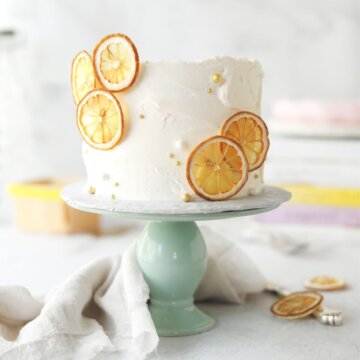
Hi! Could I use Greek yogurt instead of sour cream for this recipe ?